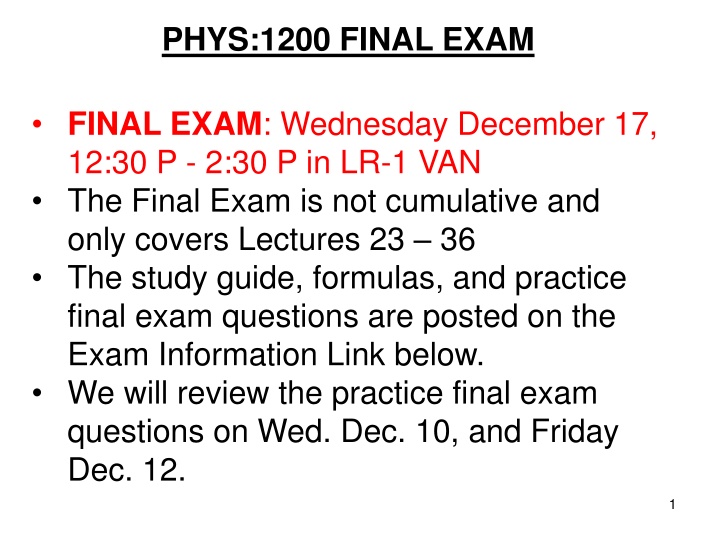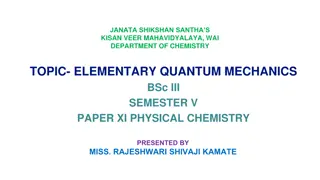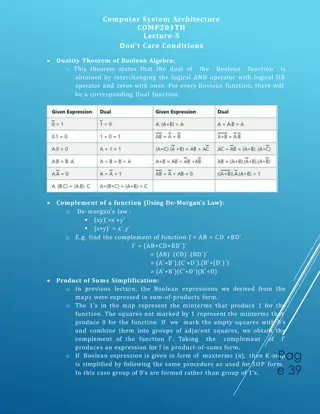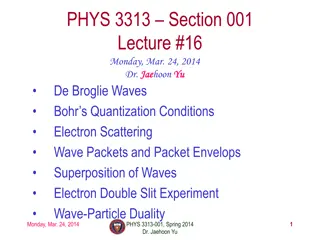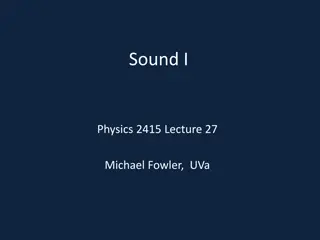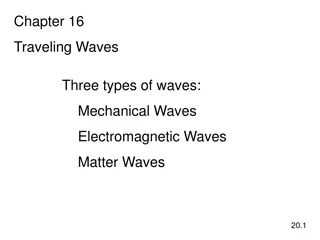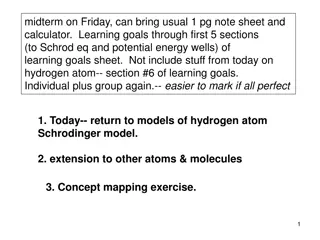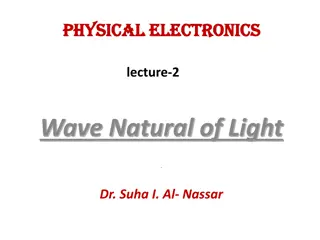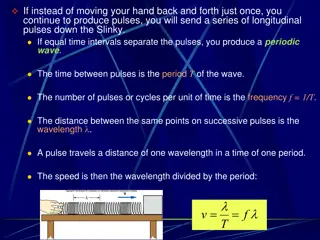Modern Physics Concepts in the 20th Century: Photons, Uncertainty, and Particle-Wave Duality
Modern physics in the 20th century blurred the lines between particles and waves, introducing concepts like photons, Heisenberg's uncertainty principle, and the dual nature of matter. Topics covered include the behaviors of electromagnetic waves, the photon concept, and the limitations of measuring particle properties simultaneously. Explore X-rays, gamma rays, lasers, medical applications, and modern imaging techniques. Delve into the fascinating world of quantum mechanics and how it revolutionized our understanding of the universe.
Uploaded on Oct 03, 2024 | 1 Views
Download Presentation

Please find below an Image/Link to download the presentation.
The content on the website is provided AS IS for your information and personal use only. It may not be sold, licensed, or shared on other websites without obtaining consent from the author.If you encounter any issues during the download, it is possible that the publisher has removed the file from their server.
You are allowed to download the files provided on this website for personal or commercial use, subject to the condition that they are used lawfully. All files are the property of their respective owners.
The content on the website is provided AS IS for your information and personal use only. It may not be sold, licensed, or shared on other websites without obtaining consent from the author.
E N D
Presentation Transcript
PHYS:1200 FINAL EXAM FINAL EXAM: Wednesday December 17, 12:30 P - 2:30 P in LR-1 VAN The Final Exam is not cumulative and only covers Lectures 23 36 The study guide, formulas, and practice final exam questions are posted on the Exam Information Link below. We will review the practice final exam questions on Wed. Dec. 10, and Friday Dec. 12. 1
L 34 Modern Physics [2] Modern physics concepts Photons Uncertainty principle X-rays and gamma rays Lasers Medical applications of lasers Applications of high power lasers Medical imaging techniques CAT scans MRI s 2
Modern physics concepts In classical physics (pre-20th Century) we studied particles and waves as two distinct entities. In modern physics (20th Century) the distinction between particle and wave behavior is not as clear. Electromagnetic waves sometimes behave like particles- photons discreet (quantized) packets of energy, as in e.g., the photoelectric effect Particles, e.g., electrons, sometimes behave as waves matter waves that can only exist in allowed orbits (Bohr s stationary states) Electrons actually have a wavelength and can experience diffraction! The electron waves are not localized like particles 3
The Photon Concept a beam of light waves also behaves like a beam of light particles called PHOTONS Photons are little packets of electromagnetic energy; they are never at rest but always move at the speed of light The energy is proportional to the frequency or inversely proportional to the wavelength Ephoton = h f, but c = f Ephoton = h c/ , where h is a constant called Planck s constant, and c is the speed of light blue photons have more energy than redphotons Light energy is absorbed or emitted in discreet amounts as spectral lines 4
The Heisenberg uncertainty principle In classical physics we can measure the position and velocity of a particle simultaneously At the atomic level, measurements can disturb what we are trying to measure To locate an electron and measure its velocity, we have to scatter (collide) a photon from it, but this will change its velocity. Uncertainty principle: It is impossible to precisely measure the position and velocity of an electron simultaneously. 5
X-ray and gamma ray photons X rays x-rays are very short wavelength photons gamma rays have even shorter wavelengths E = h f= hc/ gamma rays have more energy than x-rays 6
X-RAYS (Roentgen,1895) very short wavelength (0.01 0.1 nm) EM waves able to penetrate soft tissue, but not bone produces a two dimensional shadowimage Electrons are emitted by a hot filament (C), are accelerated and slam into a target (A) The electron s KE is converted to x-ray energy 7
X-ray machines X-ray tube 20 years ago, the x-ray images were recorded on photographic plates Now, the images are recorded on digital electronic detectors. 8
Gamma rays Gammas are extremely energetic photons x ray photons are a 1000 times more energetic than visible light photons gamma ray photons are 1,000,000 more energetic than visible light photons sources of gamma rays produced by cosmic rays that constantly bombard the earth emitted by radioactive materials (next lecture) 9
LASERS a device that controls the way that energized atoms release photons. Light Amplification by Stimulated Emission of Radiation A laser is an electro-optical device which produces a tightly collimated beam of light at a single wavelength First we must understand the difference between incoherent and coherent radiation Ordinary light sources (light bulbs, fluorescent lights) produce incoherent light lasers produce coherent, single wavelength (one color) light all atoms radiate in the same manner 10
Spontaneous vs. StimulatedEmission Ei (higher energy) Coherent radiation is produced when an atom undergoes stimulated emission. Spontaneous emission occurs when an electron makes an unprovoked transition to a lower energy level Stimulated emission occurs when an incoming photon induces the electron to change energy levels amplification photon Ef (lower energy) Spontaneous emission Incoming photon Stimulated emission 11
A Helium-Neon (HeNe) Gas Laser The wavelength of the HeNe laser is 633 nm 12
Applications of lasers Laser surgery to correct for (a) nearsightedness, and (b) farsightedness Laser cutting tools 13
Worlds most powerful laser -- NIF Size Kinnick Stadium For 1 picosec (10-12 s) NIF produces 5 x 1014 W of laser power more than all of US, a total of 1.85 MJ Its 192 beams are focused on a tiny pellet, which gets compressed and heated to conditions similar to the interior of a star, 10 MK. National Ignition Facility Livermore, CA 14
Solid State Laser Diodes Diode lasers use semiconductor materials (tiny chips of silicon) as the lasing media Power levels < 1 W When current flows through the silicon chip it emits an intense beam of coherent light. Diode lasers are used to read the information embedded in the pits in CD s and DVD s, and also to read UPC s in bar code scanners and in laser pointers! Come in a variety of wavelengths (colors) 15
Applications of modern technology Laser speed gun: sends out a laser beam that bounces off your car and back; from the time delay it calculated your car s speed CD burner: CD coated with a photosensitive dye that darkens when hit with laser light Medical imaging methods x-rays CT and CAT scans MRI s (Magnetic Resonance Imaging) 16
Tomography- constructing a 3D image from many 2D images A shadow image can be misleading two shadows taken from different angles provides a better picture shadows taken at multiple angles gives a more complete picture this is what a CT or CAT scan does 17
CAT (Computer Aided Tomography) Scans X ray images are taken at many different angles passing through the patient. Some of the slices overlap. A full three dimensional image can be reconstructed using computers. 18
Computerized Tomography (CAT scan) A computerized tomography or CT scan image is formed by analyzing x-ray shadow images taken at many different angles and positions an x-ray source and an array of electronic detectors rotates around the patient as the patient slowly moves through the ring. 19
Magnetic Resonance Imaging A CAT scan does a good job of imaging bones, but it does not provide a very good image of soft tissue CAT scans expose the patient to a large dose of x-rays, which can have long term side effects it is an invasive diagnostic Magnetic Resonance Imaging (MRI) can provide high resolution images of soft tissue inside a body, and does not use any ionizing radiation. An MRI is safer than a CAT scan. 20
MRI images the protons of the H atoms in the body of the patient If a magnetic field is turned on near a magnet, the magnet flips until it is aligned with the magnetic field The magnetic field is produced by passing a large current through a solenoid The protons in our body behave like tiny bar magnets N N S S 21
MRI How it works I. I. Rabi discovered that a magnetic field combined with radio waves caused the nuclei of atoms to "flip, a property now known as magnetic resonance. Hydrogen (H) atoms in the body are used to create a signal that is processed to form an image of the body Energy from radio waves excite the H atoms which then emit a signal that is detected by a receiving antenna The radio signal can be made to encode position information by varying the main magnetic field using auxiliary coils that are rapidly switched on and off (this is what produces the banging noise that you hear) The contrast between different tissues is determined by the rate at which the excited H atoms return to their equilibrium state 22
MRI Device The largest and most expensive part of an MRI device is the superconducting magnet which must be cooled to below 4 K The magnetic field in the device is about 60,000 times higher than the Earth s field It is critically important that NO iron is near the magnet. Iron would be pulled into the magnet. http://abcnews.go.com/US/story?id=92745 23
